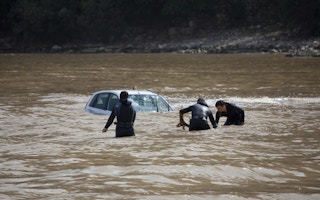In the 20 years since the first UN conference on climate change, weather-related disasters have claimed 606,000 human lives, damaged or destroyed 87 million homes, and injured, displaced or left helpless a total of 4.1 billion people.
A new study from the UN Office for Disaster Risk Reduction (UNISDR) demonstrates that 90 per cent of all disasters are now weather-related. And the average of 335 weather-related disasters per year in the last 10 years is twice that recorded between 1985 and 1995.
The report, The Human Cost of Weather-Related Disasters 1995-2015, is intended to focus attention during the UN climate change conference – which opens in Paris on Monday − on the damage already inflicted by global warming as a consequence of rising levels of greenhouse gases in the atmosphere, in turn as a consequence of the human combustion of fossil fuels and the destruction of the planet’s forests.
Development cost
As world leaders head for the summit, referred to as COP21, the numbers alone tell the story. In the last 20 years, there have been 6,457 floods, storms, heatwaves, droughts and other climatic events that meet the UN definition of a disaster − that is, they killed people, displaced communities, or caused damage calculated in millions.
But there are figures nobody can assess. One of these is the true economic cost, especially in terms of economic development.
The UN’s Centre for Research on the Epidemiology of Disasters, based at the Catholic University of Louvain in Belgium, puts the tally at US$1.891 trillion over the last 20 years.
However, that accounts for about only 71 per cent of all losses attributable to natural hazards. The true figure for disasters – including earthquakes and tsunamis – could be between $250bn and $300bn a year, which would mean a total of up to $6 trillion just for the last decade.
In terms of numbers, the US was hit most often, with 472 recorded tornadoes, ice storms, hurricanes, floods, heatwaves, droughts and other events. China followed with 441, India with 228, the Philippines with 274, and Indonesia with 263.
The greatest loss of lives was in Asia, where 332,000 people died and 3.7 billion were affected. Cyclone Nargis, which hit Myanmar in 2008, claimed 138,000 lives.
Floods accounted for 47 per cent of all weather-related disasters in the 20 years, affecting 2.3 billion people and killing 157,000. Storms accounted for 242,000 deaths, or 40 per cent of the total. Almost 90 per cent of these deaths were in the lower-income nations.
Paradoxically, higher-income countries felt the impact of temperature extremes. Of the 164,000 who perished when the thermometer dropped or climbed to catastrophic levels, 148,000 died during heatwaves, and 90 per cent of these deaths were in Europe.
Greater extremes
But drought hit Africa more than any other continent, with 136 arid spells between 1995 and 2015, and 77 of these were in East Africa.
Researchers have repeatedly given warnings that global warming is likely to be accompanied by greater extremes.
“In the long term, an agreement in Paris at COP21 on reducing greenhouse gas emissions will be a significant contribution to reducing damage and loss from disasters, which are partly driven by a warming globe and rising sea levels,” says Margareta Wahlström, head of UNISDR.
“For now, there is a need to reduce existing levels of risk and avoid creating new risk by ensuring that public and private investments are risk-informed and do not increase the exposure of people and economic assets to natural hazards on flood plains, vulnerable low-lying coastlines, and other locations unsuited for human settlement.”










